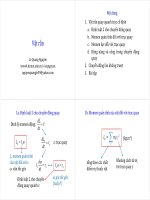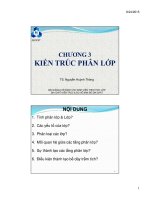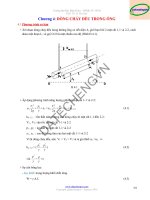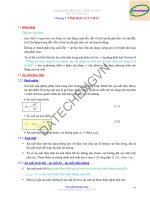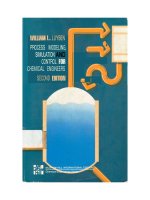Giao trinh bai tap 08 20hungarian 20method1
Bạn đang xem bản rút gọn của tài liệu. Xem và tải ngay bản đầy đủ của tài liệu tại đây (2.63 MB, 93 trang )
WELL COMPLETION and STIMULATION
Bài giảng được soạn bởi
Bộ môn Khoan – Khai thác Dầu khí
Khoa Kỹ thuật Địa chất và Dầu khí
Đại học Bách Khoa TP. HCM
Tel: (08) 8647256 ext. 5767
GEOPET
CONTENTS
1. Basic Completion Methods
2. Completion Procedure
3. Perforating
4. Stimulation
GEOPET
Well Completion and Stimulation
2
1. BASIC COMPLETION METHODS
GEOPET
Well Completion and Stimulation
3
INTRODUCTION
Once the design well depth is
reached, the formation is tested
and evaluated.
To complete the production well,
PLATFORM
casing is installed and cemented,
and the drilling rig is dismantled.
SEA BED
A service rig is brought in to
30’’ CASING
20’’ CASING
perforate the production casing
13 3/8’’ CASING
and run production tubing along
Production casing (9 5/8)
7’’ LINER
with downhole equipments.
Production begins after surface
safety equipment installation
RESERVOIR
inished.
GEOPET
Well Completion and Stimulation
4
WHAT IS COMPLETION?
Well completion creates a
dependable pathway to the surface
for the hydrocarbons.
The term ‘completion’ describes
the assembly of downhole tubulars
and other safety equipments that is
required to enable the safe and
efficient production of oil or gas
from the well after it has been
drilled.
GEOPET
Well Completion and Stimulation
5
BASIC WELL COMPLETION TECHNOLOGY
Each drilled wellbore awaiting completion is unique. Even nearby wells
drilled to the same reservoir can have differencies in:
depths,
formation characteristics,
and hole sizes
A wide variety of equipment designs and procedures have been
developed to provide safe, efficient conduits from subsurface
reservoirs to the surface in different situations.
The ideal completion design
minimizes initial completion and operating costs,
providing for the most profitable operation of an oil or gas well over
its entire life.
GEOPET
Well Completion and Stimulation
6
TYPE OF COMPLETION
Natural Completions
Natural completions are those in which little or no stimulation is required
for production. Sandstone and carbonate systems with good permeability
and mechanical stability are ideal for natural completions.
Stimulated Completions
These completions are generally applied to improve the natural drainage
patterns of hard, low-permeability formations. It is used to remove
barriers that prevent easy passage of fluids into the wellbore.
Sand-Control Completions
Sand-control completions support the formation while allowing the flow of fluids.
They are performed in young, unconsolidated or less mechanically competent
sandstones.
GEOPET
Well Completion and Stimulation
7
TYPE OF COMPLETION
The design of a particular completion depends on:
1. The number and type of productive zones,
2. The expected pressures and flow rates,
3. The need to control sand production,
4. The need for artificial lift or stimulation the regulations
governing operations in the area.
GEOPET
Well Completion and Stimulation
8
WELL COMPLETION ACTIVITIES
Well completion activities include:
Conducting well test
Setting production casing
Running production tubing along with
downhole equipments
GEOPET
Installing surface safety equipments
Starting production flow
Well Completion and Stimulation
9
BASIC COMPLETION METHODS
Once we drill to the target and evaluate our well by
Mud analysis: density & viscosity
Well logging (electrical, ascoustic, nuclear, etc…)
Coring: at bottomhole or sidewall
Welltest: bottomhole pressure vs time -> reservoir properties
Next decision is whether to complete or abandon it????
In the latter case:
set a cement plug or plugs in the hole,
possibly recover whatever casing can be removed,
and return the drill-site to its original condition.
The more fortunate is one in which our well not only is productive, but
economically justifies a completion.
GEOPET
Well Completion and Stimulation
10
BASIC COMPLETION METHODS
The next step usually involves the running of the final string of casing - the
production string.
The manner in which this is done determines the basic completion
method and may follow one of several configurations: (interface between
the wellbore & reservoir)
the openhole completion,
the liner completion,
the cased and perforated completion
• Without liner
• With liner
GEOPET
Well Completion and Stimulation
11
BASIC COMPLETION METHODS
The openhole completion: the producing formation is not isolated by
the casing, which extends only to the top of the producing interval.
The slotted liner completion: which is not cemented and not "tied back"
to the surface.
GEOPET
Well Completion and Stimulation
12
BASIC COMPLETION METHODS
The cased and perforated completion
Without liner: cementing the production casing across the
productive interval and then perforating the casing for production
With liner: a liner is cemented and perforated as a cased and
perforated completion
GEOPET
Well Completion and Stimulation
13
BASIC COMPLETION METHODS
One of these configurations will be the basis for the completion design,
which may incorporate:
one or multiple strings of tubing: single, dual, or triple, etc
and a variety of tubing components to facilitate production
(production method): pumping, flowing, etc.
from one or multiple zones: single or multiple zones
For our purposes, a cased and perforated well with a single tubing
string will serve to illustrate the typical completion procedure.
GEOPET
Well Completion and Stimulation
14
SUBSEA COMPLETION
Subsea production systems are wells
located on the sea floor, as opposed to
at the surface. The safety equipments
are installed underwater on the seabed.
They enable early production from
deepwater, remote, and marginal fields.
Subsea production system offer a
means of producing field extremities not
reachable by directional drilling from
existing platforms, or where field
economics do not justify the installation
of one or more additional platforms.
GEOPET
Well Completion and Stimulation
15
2. COMPLETION PROCEDURE
GEOPET
Well Completion and Stimulation
16
COMPLETION PROCEDURE
After the contract casing crew runs the final casing,
cementing follows the usual procedure, although stage
cementing may be necessary to cement an extremely long
string.
The production string has been hauled out to the location
and the inside diameter checked to make sure that
imperfections will not prevent the subsequent running in of
tubing and packers after the string is set.
GEOPET
Well Completion and Stimulation
17
COMPLETION PROCEDURE
Special care: to prevent the possibility of future leaks.
If stage cementing is necessary:
the bottom section is first cemented in place and then
a series of plugs are pumped down the casing to open ports that
allow the upper end of the annulus to receive cement.
After the cement has set, the inside of the casing must be
drilled out and
flushed clean of cement and other debris to a depth below that of
the proposed completion.
It is important that the inside diameter of the production casing be
clean and smooth.
GEOPET
Well Completion and Stimulation
18
COMPLETION PROCEDURE
It is also important that the cement
form a competent seal between the
casing and borehole over the entire
openhole interval. To ensure this,
an acoustic cement bond log is
sometimes run on wireline
to determine if voids exist
between casing and hole
because cement has bypassed
the drilling fluid.
GEOPET
Well Completion and Stimulation
19
COMPLETION PROCEDURE
If the bond is poor in an area, particularly if the area is between
productive formations, a cement squeeze will be required.
Often the cement bond log is run in conjunction with a gamma ray log
and a casing collar log. The drilling engineers can correlate this
gamma ray log with the logs run earlier during formation logging.
This correlation is important because as we zero in on the target - the
productive formation - our need to locate tools precisely relative to that
formation is critical.
The open hole logging sondes are subjected to a greater amount of
"drag" when being pulled up the hole, the depths at which formations
are recorded may differ somewhat from the formation depths on the
gamma ray log run inside the casing.
GEOPET
Well Completion and Stimulation
20
COMPLETION PROCEDURE
If we were to perforate the casing according to the openhole log
depths, we might miss the formation entirely. By using the correlation
log and casing collar log to set packers and perforate, we are assured
of precise placement.
At this point, many operators
move the drilling rig off location and
replace it with a less expensive, and often less powerful,
completion rig.
This gives the operator time to design the rest of the completion,
provide for a sales contract, and order equipment.
GEOPET
Well Completion and Stimulation
21
COMPLETION PROCEDURE
Whichever rig is used, the next step in the completion is to measure the
tubing while running it into the hole.
A careful count must be kept of the exact number of tubing joints run
into the hole and their total length.
With the tubing in the hole, the BOP stack, which is now attached
above the tubing head where the tubing will hang, may be tested.
The casing may also be pressure tested,
and a filtered completion fluid may be circulated into the well to
displace the drilling mud prior to perforating.
This fluid is usually a heavy brine, because it:
o provides the hydrostatic pressure needed to control the well,
o does not contain solids that can plug the perforations and
damage the formation.
GEOPET
Well Completion and Stimulation
22
COMPLETION PROCEDURE
If perforating is to be done at this point,
the tubing is removed and
the perforating gun is lowered and positioned according to the
correlation log and casing collars.
It is critical that the gun be placed precisely;
once inaccurate perforations are made, they can only be plugged
off with a costly cement "squeeze."
GEOPET
Well Completion and Stimulation
23
COMPLETION PROCEDURE
With the well perforated, it may now be time to stimulate the well by
either
acidizing or
hydraulically fracturing the formation.
Acid can be used to dissolve formation-damaging particles left by the
drilling mud or, in carbonate formations, to create flow passages by
dissolving portions of the rock itself.
Hydraulic fracturing involves the high-pressure pumping of fluid into
the formation to split the rock apart and increase its flow capacity of
tight formations.
GEOPET
Well Completion and Stimulation
24
COMPLETION PROCEDURE
Normally, a completion packer is run and set next, either incorporated
into the tubing string or set independently on electric wireline.
The packer is pressure tested to ensure its sealing ability. (Many
shallow, low pressure wells, however, do not require a packer to isolate
the casing from produced fluids.)
The tubing must then be "spaced out." This requires that a length of
tubing be removed from the upper end so that it can be "landed" in the
tubing head, which is some distance bellow the rotary table.
Once the tubing has been landed in the tubing head, a temporary plug
can be set inside the tubing while the BOP stack is removed and the
surface flow control equipment ("Christmas tree") installed. This plug
is then removed through the Christmas tree, and the well is completed.
GEOPET
Well Completion and Stimulation
25


